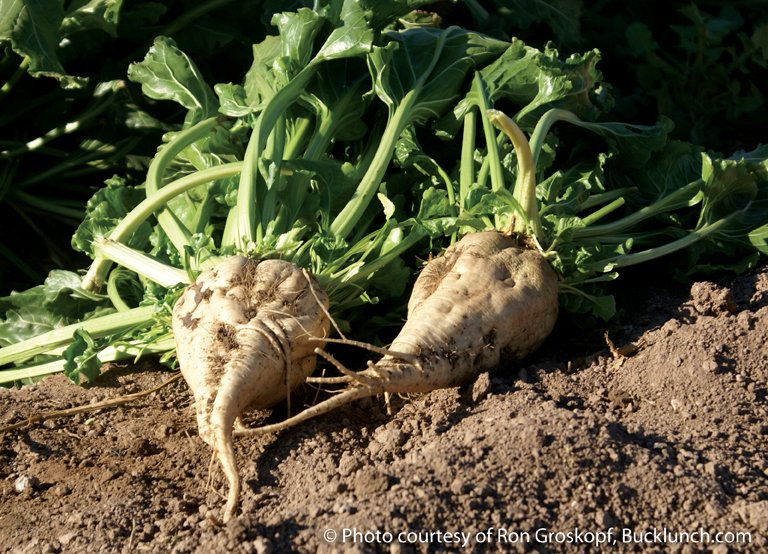For a unique addition to your whitetail food plot smorgasbord, try adding sugar beets. Sugar beets are actually an agricultural crop that is commonly grown for sucrose production. Farmers grow this large root-producing plant and process the root into sugar. Although commercial production occurs primarily in the northern United States, it can be an attractive alternative in food plots, even in some of our southern states. Deer will eat the leafy tops and also dig for and eat the roots.
Sugar beets are a biennial vegetable that can produce roots anywhere from 2 to 4 pounds when mature. The white-colored roots are very attractive to deer and contain from 13 to 22 percent sucrose. Sugar beets are highly digestible and provide a protein content of about 10 percent to deer. One acre of ground may produce as much as 15 tons of this delicious delicacy. Deer will also forage on the top of sugar beets. While deer may not immediately recognize the roots as preferred food, once they do, they will hammer them. Cool weather helps increase the sugar content of the roots and attractiveness to deer.
Sugar beets are a hardy crop that can adapt to a variety of soils. Sugar beets can handle heavier soils as long as they are in full sun and have good drainage. Sugar beets do not handle competition well and weeds should be brought under control before planting using tillage or a non-selective herbicide. Sugar beets are not super drought tolerant and need adequate rainfall to sustain a good crop. Before planting, adjust the soil to a pH of 6.0 to 6.8.
Although sugar beets can be drilled or planted in rows, perhaps the easiest way to plant them is to broadcast the seed. Broadcast seed at a rate of 8 to 10 lbs./acre. Because of their lack of tolerance for competition, sugar beets do best when planted as a stand-alone crop. Seed should be dragged in and cultipacked to no deeper than three quarters of an inch. Fertilize the crop according to soil sample results or broadcast 400 pounds of 13-13-13 or 300 pounds of 19-19-19 per acre. Additional fertilizer can be added a month or two later to boost the production of the crop.
Occasionally, sugar beets can experience some problems from root rots, powdery mildew or leaf spots. Cut worms, flea beetles, wire worms and white grubs can also be troublesome pests. Consult with your local county extension office for fungicide and pesticide recommendations if the problem becomes too serious. In most cases when used just for food plots, most pest problems can be ignored.
Sugar beets can reach maturity in 90 to 100 days and grow best when daytime temperatures are between 60 to 75 degrees and nighttime temperatures between 40 to 50 degrees. Sugar beets can be planted in late spring in the North or early spring in more southern locations. Deep South states like Louisiana, Florida, South Alabama, South Georgia and similar areas are not well suited for growing this crop.
In the full profile of sugar beets in Quality Whitetails magazine, I go into more detail. Join QDMA to start receiving the magazine, which includes a full-length Food Plot Species Profile in every issue.
